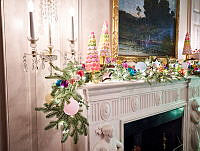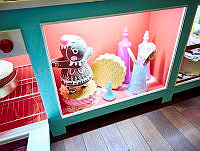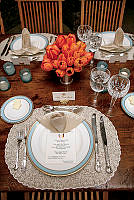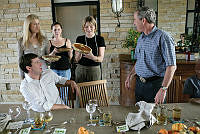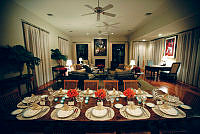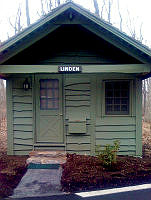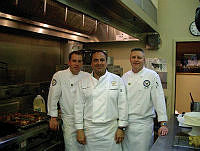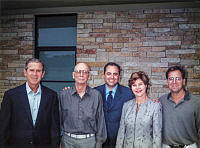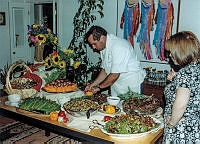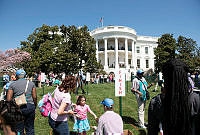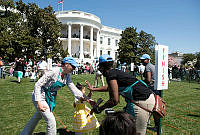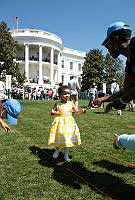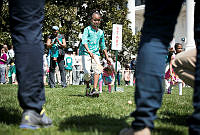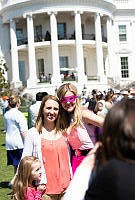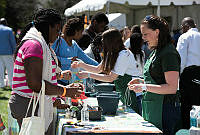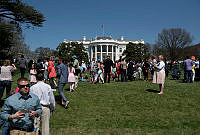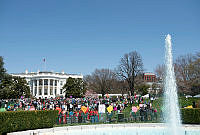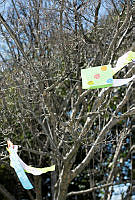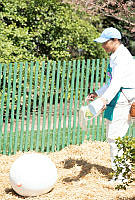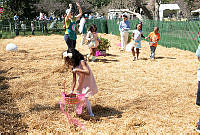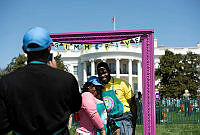The President and Washington During the War with Mexico
Copyright © June 01, 2013 White House Historical Association. All rights reserved under international copyright conventions. No part of this article may be reproduced or utilized in any form or by any means, electronic or mechanical, including photocopying, recording, or by any information storage and retrieval system, without permission in writing from the publisher. Requests for reprint permissions should be addressed to books@whha.org

The monumental United States Patent Office built of dressed Aquia stone is seen here as originally completed, about 1846. Subsequent additions would greatly enlarge it. During Polk's time, the building loomed over the small domestic structures lining K Street.
Library of CongressJames Knox Polk was at home in Columbia, Tennessee, when he judged that it was about time to find out the results of the election. A dispatch from Washington was waiting for him at the post office. And the news of his presidential victory marked not only a change in his life, but marked, in retrospect, the start of the last four years of that life. It was November 1844.
Polk and his wife Sarah emerged on the national stage that winter. Crowds came out to see them all along the way to Washington. Arriving by steamboat, at Wheeling, Virginia, they prepared to board the railroad train to Baltimore. A band had assembled to play in their honor, while a large crowd looked on. Mrs. Polk refused to leave her cabin, it being the Sabbath. It was her very first national act. She had no use for frivolity, identifying with the simpler interpretation of Presbyterianism; however, she loved elegant embellishments, from clothes to furnishings, an appetite she pursued with thrift, but a not necessarily Presbyterian strictness.
They were an interesting couple, if somewhat strange looking, Polk smallish and spare, graying, steel eyed, thinning hair, and not much to say outside business. She was dark eyed, dark haired, described as “handsome,” a clever and earnest woman who made no secret that she was Polk’s shadow and adviser. “Mrs. Polk was always in the parlor with Mr. Polk,” one observer remembered of social occasions.1 She was forty-two and he seven years her senior. They had been married for twenty-one years and like many childless couples, surrounded themselves with young relatives. Knox Walker, who served as the president’s secretary and lone assistant, lived with his wife and children in the family quarters. Mrs. Polk’s Tennessee nieces numbered sometimes five or six, visiting “Aunt Sally.”
When they arrived in Washington they already knew well the capital that greeted them, Polk having served in Congress for fourteen years. The outgoing president, John Tyler, and his new wife, were presiding over a lively White House. They held a dinner for the Polks on March 2, 1845, to celebrate the annexation of the Republic of Texas. The Polks dined very probably in the same room where less than a decade before President Andrew Jackson had entertained General Antonio López de Santa Anna, president of Mexico, and a prisoner of Texas sent to Washington for the president to deal with. Santa Anna was sent back to Mexico and soon would become Polk’s adversary in the coming war.2
The president was inaugurated in rain and thunder on March 4, 1845,
and the Polks settled down once again as citizens of Washington, only
this time as the citizens of Washington. He was a hard, constant worker
in his office on the east end of the White House Second Floor, with no
time for idle amusements, nor did he permit Knox to have much fun,
chastising him once for attending one Sunday a “party of pleasure” in
Annapolis. Mrs. Polk was the Polk most often seen in Washington. She
loved to shop, with her nieces fluttering along. Dolley Madison, who lived across Lafayette Park, was an old friend and received from Mrs.
Polk the affectionate attention she might have bestowed upon an aged,
but spicy, aunt. Attending church services faithfully, often bringing
the president along, she walked down the center aisle never before the
second hymn, her hat adorned with feathers, her dress rich and elegant.
On frequent drives in her open carriage she was admired by the citizens.
Once she had a guard at the Capitol fired for not recognizing her, then
having the cheek to stop her carriage from proceeding beyond the gate.

The White House from the south. Taken in 1846 by the daguerrean photographer John Plumbe Jr.
Library of CongressThe tireless president lost no time in addressing the issues that had brought him to office. Expansion was the objective of the time, wrapped dreamily in the philosophy called Manifest Destiny. Historically, imperialism seems to have come upon the United States all at once, during Polk’s administration; of course it did not, but it had rarely before been impassioned. So bold were the words and actions of the new president that the minister from Mexico went home three weeks after the inauguration. On January 13, 1846, ten months after the inauguration, Polk ordered General Zachary Taylor to the Rio Grande to establish by his presence the southern border of Texas and thus the United States. General Mariano Paredes, who had just assumed the presidency of Mexico, declared Taylor’s appearance an invasion. When some American dragoons (cavalry) were captured by Mexican forces in April, the news triggered Polk’s war message of May 13, 1846, and war was declared the next day.
Gradually through the summer Washington became the headquarters of an international war, except that, unlike the previous war with Britain a little more than thirty years before, not on its own ground. Militia companies appeared now and then from various parts of the Northeast and South, bound for Mexico. The president reviewed them either from the White House portico or on horseback as they marched before him on Pennsylvania Avenue. Some camped outside town, but many raised their tents among the cedars and elms in Lafayette Park. Receptions were held at the White House, with the militiamen invited. Officers of the army were in and out. Large crowds gathered to see them march or fire their rifles or loll about their campfires. But for the most part the war was far away in Mexico.
Washington itself was much the city it had always been. Perhaps the finest document available to the historian of Mexican-American War Washington is not the written page but a small number of superb daguerreotype images taken in the first year of the war. Photography was new, and these are amazing. A few of them have been shown before in White House History, but they accompany this article in their entirety. The window they open visually on Polk’s wartime Washington is memorable and would have been impossible before about six years earlier. The attention to detail and their clarity makes them about as close to total recall as one can get.3
Washington, with the government as its economic spine, was a prosperous city of about 40,000, no small size compared to most other American cities. A large percentage worked for the federal government. Andrew Jackson’s “spoils system”—“To the victor go the spoils”—still prevailed. That the fruit of spoils was the assurance of loyalty to elected officials was still the strongest argument. Yet the spoils system was not usually as penetrating as sometimes seen. There was turnover in public employees, however, and some turnover when administrations changed. In the first year of the Mexican-American War, Congress retroceded Alexandria, an original part of the federal district as established by George Washington, to the state of Virginia, pulling the capital boundary to the western bank of the Potomac.
Most of the neighborhoods were close in, and one could walk easily from the White House to working farms on the outskirts of the city. Farmers brought produce to the city in pushcarts and some horse- or ox-drawn wagons. They assumed places in stalls in one of the markets. Most people shopped for groceries daily. Mrs. Polk appointed Henry Bowman as steward at the White House to cut costs where he could. One of his means was to make arrangements with various suppliers to appear at the White House kitchen before they went to market, so he and the cook would have the best of what he wanted. Some of his suppliers had contracts, such as the baker, who made thousands of rolls and ladyfingers for the first table. In the latter case Mrs. Polk’s favorite dessert seems to have been charlotte russe, made by lining a baking pan with ladyfingers and filling the center with chocolate and sometimes also berries.

Pennsylvania Avenue looking northwest, from a perch on Capitol Hill, about 1848. Washington’s crowded “main street” stretches to the White House (dimly visible on the left). The larger building on the right is the Winder Building, completed during the Mexican War.
National Archives and Records AdministrationInnovation came relatively early to Washington in that the government was likely to use the capital as an experimental place. Running water had come to the government buildings in 1833. A flowing spring at Franklin Square, several blocks northeast of Lafayette Square, was dug out and fitted with wooden pipes. The pipes, glued together with tar and pegged, followed an incline to a large area next to the Department of State, adjacent to the White House North Lawn. There a large pond was dug, its bottom about 2 feet of clean, white creek sand that had been brought in. A noisy steam-powered fountain in the edge kept the water agitated, and encouraged it through further links of pipes to the executive offices and the White House, where hand pumps drew it into glass bottles or demijohns at every station where water was to be dispensed. Kept full, the demijohns yielded their water by the push of a lever. The water system was available only in halls. It was a great convenience.4
Nearly as convenient, and perhaps a little scary, was the introduction of gas in 1846. A trunk line was buried down the center of Pennsylvania Avenue from the Capitol to the White House. Coal gas was generated at the gas plant and pushed into the pipes, and the Capitol, White House, and four executive office buildings boasted gaslight. Mrs. Polk disliked the tawdry gas flames so she ordered that the Blue Room be left with a candle chandelier. She was vindicated when during a reception all the gaslights blinked out at 9 p.m., as she knew they would; with great care she had meanwhile placed herself beneath the candle chandelier in the Blue Room, illuminated by a very flattering mass of candles from above.5
Gas had its issues. No sooner had it been installed than merchants and shopkeepers along Pennsylvania Avenue—the downtown of Polk’s time—tapped into the trunk line and lighted their businesses at government expense. No penalty seems to have followed the discovery of this, only that they pay their gas bill upon reading the little jug-like meter the city officials fused into the illicit pipe.
Because the White House was ten to twenty years in use without major refurbishing, it befell the lot of Mrs. Polk to dress it up. For assistance she turned to William Wilson Corcoran, the local banker, who had made a fortune in the past and was making more again from financial arrangements he was negotiating for the USA with the government in England to pay for the war. Corcoran’s taste was considered flawless. He traveled to New York and selected furniture, upholstery, wallpaper, carpeting, and china for Mrs. Polk. They created a new state parlor, the Red Room. While it had been red before, the Corcoran red, with all its matching parts, must have been memorable, for the room has been the Red Room since.6
Pennsylvania Avenue was paved, with walks along the sides. Dirt collected between the pavers and finally buried some of them, becoming the bottoms of pools of water in hard rains. Dry summer days the street stank from animal excrement, and according to some accounts dead animals were not removed with much alacrity. Dust hung in the air, whipped up by horses and carriages of all descriptions during the day. Storekeepers rigged awnings from white canvas, held up on pipe frames, to shade the first story walls of their stores and also provide some shade for the windows and shelter from rain for outdoor displays and pedestrians.

Polk’s cabinet seated in the State Dining Room in June 1846. The earliest interior image known of the White House, this daguerreotype captures details of the room as well as the features of the group who managed the War with Mexico. The one objector is George Bancroft, Secretary of the Navy—the man on the right, in the white vest—who would resign that month in protest.
James K. Polk MemorialLooming over it all was the Capitol. It was still in the old form, which within a few years would be replaced. The Capitol as finished by Boston architect Charles Bulfinch in 1821 had a bulbous dome sheathed in metal and painted canvas. It was a beautiful building, of monumental proportions in white marble, large in scale. At its feet was the Mall, much diminished by intrusions man made and mud holes and weed beds made from Above. Tiber Creek, which is today covered by Independence Avenue but still flows in a mad race to the Potomac, was a wide open sewer in Polk’s time. Here and there a sailboat or barge still patronized it, as Pierre Charles L’Enfant had intended, giving water communication around the central city.
Illuminations followed the good news from Mexico, which came in staccato by military courier and, now and then, telegraph wires. Every house in the inner part of the city was lighted as much as possible. The stores sold small tin spikes that would hold a candle upright while its arrow-like base was thrust into the windows or wood trim. Thousands of candles glowed the night in early April 1847 with the triumphant end of the siege of Vera Cruz late the previous month. Bonfires blazed at the intersections and crowds cheered and cheered on and built more fires as the months passed for Cerro Gordo, Contreras, and Churubusco, Molino del Rey, Chapultepec, and at last the fall of Mexico City that ended the war.
Communication was by no means instant. The electric telegraph had only been introduced to Washington three years before the start of the war but its commercial use made it spread very quickly, if not enough to be of value to wartime Washington. It was still not a major feature of government operations. Couriers were the basic bearers of information. All the news of the war came by them, taken by sea from Mexico across the Gulf of Mexico to New Orleans and then upriver by steamboat. Not all messages related directly to the war.
In the final treaty with Mexico, the United States stretched to the Pacific Ocean. A grateful people elected General Zachary Taylor president in 1848. James K. Polk, on the home front, had reorganized government bookkeeping, established a voucher system, and matched Thomas Jefferson in doubling the nation’s territory. With a large shipment of furniture almost identical to what Corcoran had bought for the White House, James and Sarah Polk returned to Tennessee when his administration ended, inspired to create a home filled with papers and artifacts that would one day be a museum. Had it worked out, theirs would have been the first presidential library. He died in 1849, three months after leaving Washington, and she followed him forty-two years later, on the eve of the twentieth century.

A gathering on the South Portico of the White House, about 1848. James and Sarah Polk, are front center. The turbaned head to the president’s left is that of the by-then-legendary Dolley Madison, who had returned to perform again on the stage of her glory.
George Eastman House



















